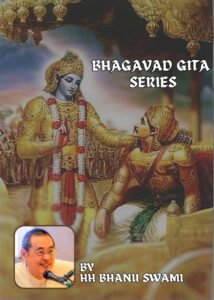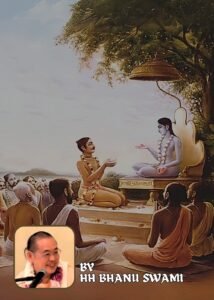SB 10.52.41 by HH Bhanu Swami Maharaj on Dec 10, 2024 @ ISKCON JAPAN
ŚB 10.52.41
śvo bhāvini tvam ajitodvahane vidarbhān
guptaḥ sametya pṛtanā-patibhiḥ parītaḥ
nirmathya caidya-magadhendra-balaṁ prasahya
māṁ rākṣasena vidhinodvaha vīrya-śulkām
Translation
O unconquerable one, tomorrow when my marriage ceremony is about to begin, You should arrive unseen in Vidarbha and surround Yourself with the leaders of Your army. Then crush the forces of Caidya and Magadhendra and marry me in the Rākṣasa style, winning me with Your valor.
Purport by the disciples of Srila Prabhupada
As Śrīla Prabhupāda points out in Kṛṣṇa, the Supreme Personality of Godhead, Rukmiṇī, being born of royal blood, certainly had a brilliant grasp of political affairs. She advised Śrī Kṛṣṇa to enter the city alone and unnoticed and then surround Himself with His military commanders so He could do what was needed. Śrīla Viśvanātha Cakravartī compares the coming fight to the Lord’s churning of the ocean to extract the goddess Lakṣmī. Gorgeous Rukmiṇī, the goddess of fortune, would be gained in the coming turbulence.
HH Bhanu Swami Maharaj:
So, here, Rukmini actually has thought of the whole plan, what to do, and she’s explaining this to Kṛṣṇa . So, she is proposing that Kṛṣṇa come to the city secretly. But also bring his troops. And then, steal, Rukmini, in the Rakshasa style. So, this is called a Rakshasa marriage, which makes it sound very demoniac. Actually, we can say it’s a customary type of marriage among Kshatriyas.
So, the positive point here is that, it becomes a show of strength of the qualified groom. So, traditionally, the husband of a great princess should be very qualified. So, therefore, the test would be how he can defeat all the other competitors. And it’s also not uncommon in other places in the world as well. In this case, of course, the difference is that this is Kṛṣṇa and his eternal consort. So, they’re eternally married, there has to be no test at all.
However, when the Lord appears in the material world, then we get an opportunity for arranging these types of things like marriage. So, Kṛṣṇa appears at a certain time in pastimes, and Rukmini appears also, and then they meet and they marry. At the same time, they’re eternally existing in the spiritual world, in a married state. But for pastimes, we have this variety within the marriage. And it gives an opportunity to express different emotions.
Of course, people will object, well, why should they have emotions? Emotions are material. Emotions in the material world give rise to all sorts of violent activities and sinful activities and suffering. And so that is very true. And that is recognized by the great poets. So, to portray material events and material passions, they have constructed, say, a theory of rasa, material rasa. So, rasa is based on relationships between people.
So material rasa will depict material relationships between people. And we’ll see, in the relationships, there is often anger and fear and all these negative emotions. Of course, we will look at spiritual rasa, described in Nectar of Devotion, there’s fear and anger and all these things, and they’re all very secondary. They appear and disappear very quickly. So, they add a little bit of colour or variety to the pastimes in the spiritual world. In the material world, secondary rasas in the spiritual world become like primary rasas in the material world.
So in this way, the secondary rasas in the spiritual world become very prominent in the material world. And if we have positive relationships of love, they’re not eternal. They will fail. Somebody will die. So, therefore, it ends up in secondary rasas becoming very prominent again. So, when the Lord comes to the material world, then He will display pastimes and He will display the secondary rasas.
So, Rukmini is expressing fear. Kṛṣṇa will experience or express ‘virya’ here, which is a type of rasa, a courageous display. But other stimulus for this is their positive rasa, that is, madhurya rasa. And, though these secondary rasas appear, ultimately they marry and they continue eternally with madhurya rasa. So, when Kṛṣṇa appears in the material world, this gives a little more variety to His rasas.
So the whole purpose of Bhāgavatam is to show the rasa of Kṛṣṇa. So, He’s designated in the first canto as Bhagavan Svayam, the highest, most complete form of the Lord. And though He is complete in strength and so many qualities, ultimately His completeness is completeness of rasa. So, at the beginning of Nectar of Devotion, Rupa Goswami explains that technically all the forms of God are one, so therefore there’s no difference between them. But Kṛṣṇa is designated as superior to all the others. Why? Because of rasa.
So, there is rasa in all the forms of the Lord in all the pastimes, but with Kṛṣṇa it is a most complete display. And that is displayed through different pastimes. So, Bhāgavatam describes the pastimes of Kṛṣṇa in the tenth canto, and through that we can understand how He is Svayam Bhagavan.
In Ujjvala-nīlamaṇi, Rupa Goswami describes that Kṛṣṇa has many, many facets, many personalities, so to speak. And particularly in Madhurya Rasa, He has so many different personalities. And He will display these personalities in Vrindavan. But then He will display the same qualities in one sense, but slightly different in Dwaraka, so therefore it’s double. All the qualities become double because He’s got the same qualities but slightly different. So, the devotees, by hearing Bhāgavatam , they can appreciate the many qualities of Kṛṣṇa .
In that way, they can understand why Kṛṣṇa is designated as Bhagavan Svayam.
Okay. Hare Kṛṣṇa !!!
Q & A
1) You said Dwaraka form of Krishna has double the qualities? How is it?
Yes, so whatever qualities we have in Vrindavan, also they’re in Dwaraka, but slightly different. So therefore we get different qualities, double.
Yeah, same qualities but slightly different, so therefore it doubles the number.
Devotee : Slightly different means Dwaraka.
HH Bhanu Swami Maharaj : Slightly means Aishwarya mixed with everything there in Dwaraka .
Devotee : Added by more Kshatriya. Use Aishwarya for Madhurya. Stimulate Madhurya by Aishwarya.
HH Bhanu Swami Maharaj :For instance, in Vrindavan we have Krishna and Radha and the eight Sakhis. So the eight Sakhis and Radha expand. Their expansions are in Dwaraka , so in one sense they’re the same but in Dwaraka it’s also different. It’s the same Rasa in one sense, but it’s tinged with this Aishwarya in Dwaraka .
And because of that covering the prema is less intense and it is said that the queens of Dwaraka do not experience Mahabhava, only the gopis of Vrindavan experience it.
Devotee : Thank you very much Maharaj.
2) In Nectar of Devotion, Rupa Goswami mentioned the five characters of Krishna, dhīrodātta, dhīra-lalita, dhīra-praśānta and dhīroddhata . Could you explain this?
Actually those are explained there in the Nectar of Devotion itself. So these are different personalities.In the material world, generally one person will have one personality.
So I think in dhīra-lalita, Krishna is a lover, but lalita means he is very playful, joking. So he likes to flirt and joke and play around.
Another form is he is very proud and aggressive. In another form he is very noble, he has very good conduct.
So Krishna will display all these five different types of personalities in different conditions.
3) Based on these five, can he express in unlimited ways?
Okay, this is of course one way of expressing it, because it’s only five. You could have 20 or 50 or whatever, but they’ve given five in this way. But there are other ways in which he can also express himself.
Devotee : Thank you very much, Hare Krishna.
HH Bhanu Swami Maharaj : I believe these are also there in material rasa. And probably that’s where Rupa Goswami got these visions, because in portraying characters, lovers in the material world, then they found these five different types of ways you could portray the person as being very playful, being very noble, being very bold and whatever like that, so he’s just taken up on that.
4) In material world we have different personalities and they think it is schizophrenia but we see that everybody , all of us we have different personalities according to time, place, circumstances and relationship we have with different people. So why in material world they say you are schizophreniac, when actually these different personalities are present in the Supreme lord and we are the reflections of Lord and so they are present in us ?
HH Bhanu Swami Maharaj : [Laughing] Voice not clear.
I think it’s not actually called schizophrenia, it’s called multiple personality disorder. It’s not exactly schizophrenia, it’s more of an extreme form.
Devotee : Bipolar or something.
HH Bhanu Swami Maharaj : So, multiple personalities, and persons will display that, depending on the situation, they change their personality. Now, the problem in the material world is that the person really has no control over what personality is going to manifest when.
And a personality will arise in a person like this, not because of, let’s say, to make the situation better, it’s because they want to escape from something.
So, it is very difficult for other people to deal with that person, because they keep changing according to the situation. And probably you can’t even speak rationally with the person, because they keep changing their personalities.
So, with Krishna, on the other hand, everything is handled very nicely, so that all these different personalities are used in very appropriate ways, which will increase Rasa.
We can say that multiple personality disorder will destroy Rasa.
5) I would like you to tell us about the characteristics of Lalita and Vishaka separately.
Just as Krsna has all these different qualities and personalities etc. Other gopis also have different personalities and character. However among the gopis they don’t have multiple personalities. So there in Ujjvala Nilamani, Rupa Goswami explains there are around 125 different varieties of personalities of gopis. So we have the very bold ones like Lalita. And the gentle ones like Vishaka. And then we have the one in between, Madhya, that’s Radha. And then we have others who are very innocent.
In this way there’s all sorts of divisions and then they mix together and we get all sorts of varieties.
HH Bhanu Swami Maharaj : I don’t know the actual number is , if you look there for the numbers.
6) Maharaj, like here, like Rukmini is giving direction, what you should do. But in Vrindavan, we don’t see like that. The Radharani giving some direction to Krishna. So can we say like this is the difference between Madhurya in Dwaraka and Vrindavan. This is Aishwarya that you demand, direct Krishna in Dwaraka.
Well to some extent we will see even in Vrindavan, Radharani will write a letter, okay we have to go here, we have to met at a certain place, you have to do this, you to disguise yourself so nobody sees you. So we have a little bit of Krsna’s directions also for their meeting.
One other difference of course is in Vrindavan, generally it is Parakiya. So everything has to be hidden. Here in Dwaraka, everything is through marriage. So it’s a little more open.
But of course here they are planning to do Rakshasa marriage, so it’s also a little bit secret.
7) Is this Aishwarya like it’s open and bold, that’s why it is Aishwarya? Because here it’s not exactly like…
HH Bhanu Swami Maharaj : Well it’s a combination of things. One is that of course it is more Aishwarya. Another is that in Dwaraka it’s generally marriage. So in that sense it’s a combination of factors.
But of course if it is Aishwarya, we would expect that all the queens would also be more subservient. In Vrindavan they don’t see Krishna as supreme lord, so the relationship is more informal.
8)Maharaj, then these characters we were talking like that. So in that case, in the material world it’s opposite, but then everybody will have a tendency to have Parakiya Rasa. In the spiritual world it’s there for Krishna. So it should be in the material world also. So it will automatically have material Rasa, but everybody will have a tendency to have Parakiya Rasa, outside marriage.
So we have married relationships, and we have unmarried relationships also. But even though the material world is a reflection, there is also a reversal. So therefore Parakiya Rasa is condemned in the material world and marriage is praised.
In terms of aesthetics, in material rasa, Shanta rasa is the highest, Madhurya is the lowest. And secondary rasas become like primary rasas, and primary rasas become like secondary in the material world, so things are reversed in this way.
Devotee : So the married person in the material world will naturally have a tendency for extra affairs? So they both will have a tendency to have some other affairs also.
HH Bhanu Swami Maharaj :Because it’s in the spiritual world?
Devotee : Yeah.
HH Bhanu Swami Maharaj : Well, no, the tendency we will have other affairs in the material world because everybody has lack of sense control , lust and anger and things like that in the material world. So it’s all due to the gunas. So to control the mind and lust, anger, greed, etc., we have rules in the material world.
Devotees: Grantharaj Srimad Bhagavatam Ki.. Jai ! Srila Prabhupad Ki.. Jai !! HH Bhanu Swami Maharaj Ki.. Jai !!


